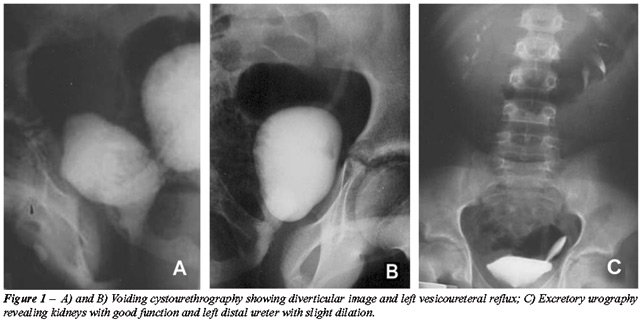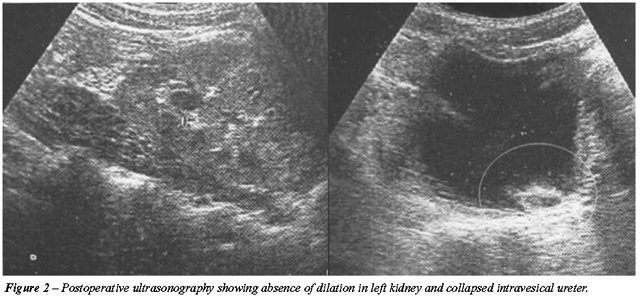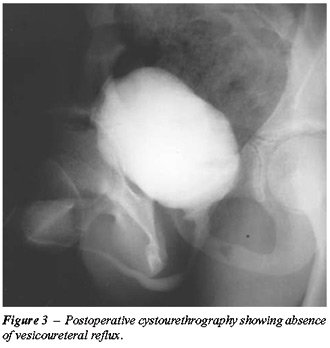LAPAROSCOPIC
TREATMENT OF REFLUXING SEGMENTAL MEGAURETER
(
Download pdf )
ANUAR I. MITRE, VITOR C. PAGOTTO, VASCO A. CRIVELLARO
Discipline of Urology, Jundiai Medical School , Sao Paulo, Brazil
ABSTRACT
We discuss the case of a 13-year old boy with urinary infection who was preoperatively diagnosed with left vesicoureteral reflux associated with paraurethral saccule. Laparoscopic Lich-Gregoir anti-reflux surgery was then proposed. Intraoperatively, we observed segmental megaureter that was successfully treated by the proposed technique without ureteral modeling, contrary to the rule that respects the 3-5 times ratio between the submucous path and the ureteral diameter.
Key
words: ureter; congenital abnormalities; replantation; laparoscopy
Int Braz J Urol. 2005; 31: 356-8
INTRODUCTION
The diagnosis of segmental megaureter in children is uncommon and, when treatment is required, there is no therapeutic standardization. We describe one case of primary refluxing segmental megaureter with episodes of acute pyelonephritis that was treated by laparoscopy. There was no available published work on the laparoscopic treatment of megaureter.
CASE REPORT
A
13-year-old male patient was investigated due to an episode of acute left
pyelonephritis. An ultrasound of the urinary tract showed signs suggestive
of scar in the left renal parenchyma and dilation of the juxtavesical
ureter on the same side. Voiding cystourethrography demonstrated a low
grade left vesicoureteral reflux and an image compatible with left paraureteral
saccule (Figure-1).

The proposed management was by Lich-Gregoir
anti-reflux surgery through transperitoneal laparoscopic approach. We
performed 4 punctures with 2 trocars measuring 10 mm and 2 trocars measuring
5 mm. During the procedure, we observed refluxing segmental megaureter
instead of the paraureteral saccule as previously diagnosed.
Following ureteral dissection, we performed
a long incision on the detrusor muscle and a wide lateral dissection of
the bladder mucosa, and the entire dilated ureteral segment was placed
in the submucous tunnel. Variable bladder fillings with saline solution
made this dissection easier. The peritoneal cavity was drained by a Penrose
drain for 24 hours and the vesical catheter was maintained for 48 hours.
Surgical time was 180 minutes.
The patient remained asymptomatic and the
control tests after 7 months demonstrated absence of vesicoureteral reflux
and absence of dilation in the left kidney respectively on voiding cystourethrography
and ultrasound (Figures-2 and 3).


COMMENTS
In
children, megaureter can be defined as an ureter whose diameter is larger
than 7 mm. Currently, megaureter is thought to be related to 20% of urological
anomalies diagnosed during the prenatal period (1).
The diagnosis of refluxing megaureter is
usually established by ultrasound of the urinary tract that shows ureteral
dilation and is complemented by voiding cystourethrography. In this case,
the patient also underwent an excretory urography that showed dilation
in the distal ureteral segment that was milder than the voiding cystourethrography
had shown.
For a successful ureterovesical replantation
of refluxing megaureter, ureteral modeling is required in order to maintain
the proper 3-5 ratio between the length of the submucous path and the
ureteral diameter. Several authors had good results with the extravesical
Lich-Gregoir technique for treating vesicoureteral reflux, with the well-established
advantages of laparoscopy (2,3).
The intraoperative finding of segmental
megaureter prompted the decision to implant the dilated ureteral segment
in the submucous path. We have no knowledge of any other report of laparoscopic
treatment for segmental megaureter that was performed as we did. Surprisingly,
though the relationship between the ureteral diameter and the length of
the submucous path was not maintained, the vesicoureteral reflux disappeared
and the walls of the submucous ureter remained in contact, giving the
impression on ultrasound of an empty ureterocele (Figure-2). Perhaps the
elasticity in the dilated ureteral segment could explain the favorable
result. It remains unknown if this method of minimally invasive treatment
would be effective in cases of non-segmental megaureter. Other studies
are required in order to question the validity of the diameter/length
of submucous path ratio in anti-vesicoureteral reflux technique.
REFERENCES
- King LR: Megaureter: definition, diagnosis and management. J Urol. 1980; 123: 222-3.
- Ehrlich RM, Gershman A, Fuchs G: Laparoscopic vesicoureteroplasty in children: initial case reports. Urology. 1994; 43: 255-61.
- Kawauchi A, Fujito A, Soh J, Ukimura O, Mizutani Y, Miki T: Laparoscopic correction of vesicoureteral reflux using Lich-Gregoir technique: initial experience and technical aspects. Int J Urol. 2002; 10: 90-3.
___________________
Received: April 5, 2005
Accepted after revision: June 16, 2005
_______________________
Correspondence address:
Dr. Anuar Ibrahim Mitre
Rua Dona Adma Jafet, 50 / 44
Sao Paulo, SP, 01381-050, Brazil
Fax: +55 11 3214-1694
E-mail: anuar@mitre.com.br